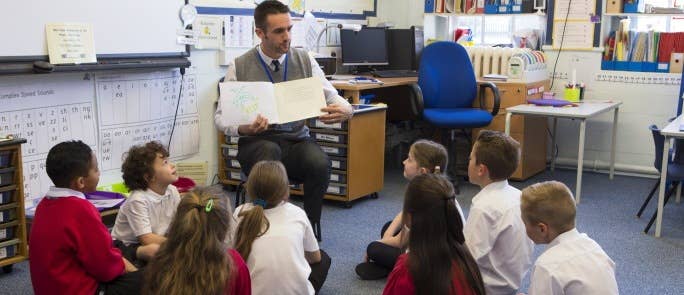ABC Chart for Challenging Behaviour: Free Template
Although a career working with children can be fun and rewarding, it is not without challenges. One of these is managing challenging behaviour. Although there are many strategies out there to help manage behaviour, occasionally you will need to gather information and evidence to help you understand the context of behaviour in relation to the student’s environment. This will help you develop an effective approach.
In this article, we will outline the ABC recording method, and how using it might help you analyse the behaviour of children you work with. We provide a handy downloadable chart which you can print off and use as part of your strategy.
What is the Antecedent Behaviour Consequence (A-B-C) model?
A-B-C or ABC recording is a way of collecting information to help determine the function of a child’s behaviour. It does this by breaking down your observations into three elements:
- Antecedents (A): what happened directly before the behaviour occurred.
- Behaviour (B): the specific action(s) or behaviour of interest.
- Consequences (C): what happened directly after the behaviour occurred.
Thinking of behaviour in these terms helps to understand why a child is behaving in a particular manner. This allows more meaningful interventions rather than just trying to prevent the behaviour itself.

Once collected, ABC information can provide some valuable insights on its own. It can be used informally by you to identify patterns of behaviour and subsequently develop effective management strategies. This can be applied in all sorts of settings, from parents at home, to teachers in the school classroom.
More formally, ABC information can be used as just one part of a larger ‘functional behaviour assessment’. These functional assessments of behaviour may be carried out by specialists as part of the process of addressing challenging behaviour for children with autism or learning disabilities, as recommended in NICE (National Institute for Health and Care Excellence) guidelines (links in Further Reading).
History and Context of the ABC model
Fundamental theory
Breaking down behaviour into antecedents, behaviours and consequences has its roots deep within behavioural psychology of the 20th century. B.F. Skinner (1904-1990) described this as the ‘three-term contingency’ of operant conditioning. Operant conditioning is the theory that learnt behaviours can be encouraged by positive reinforcement, or discouraged through withholding positive reinforcement or applying punishment. It makes the crucial link between the behaviour itself (which occurs due to a trigger/antecedent) and the consequences after the behaviour occurred.
Application of theory
This concept underpins the field of applied behaviour analysis (ABA) which originated in the 1950s. ABA subscribes to the general modern view that all behaviour has a purpose or function. ABA attempts to reduce the occurrence of challenging behaviour by understanding this function, then changing the antecedents, consequences, or both. It also aims to replace challenging behaviours with those of a more socially accepted function. For example, giving a child coloured cards to obtain attention from a teacher instead of standing up and shouting out.
Although closely linked to autism intervention, ABA principles form the basis of behaviour management strategies in a wide range of settings from home to healthcare. There are even whole books dedicated to using ABA for behaviour management within general school classrooms.
Modern iterations and extensions of ABA include the development of the functional assessments, function-based intervention and implementation of positive behavioural support (PBS) systems that we know today.
How ABC charts developed
ABC charts arose from a need for better methods for recording direct behaviour observations. The ABC method was first described by the applied behavioural scientist Sidney Bijou in a 1968 research paper (though note that the terms ‘ABC analysis’ or ‘ABC chart’ and the like, were coined later).
At the time, this paper was revolutionary in influencing the way behaviour was recorded. Previous behaviourists often described observations as a running narrative of events without any separation. Applying the A-B-C structure broke these narratives down into a series of events defined by triggers, actions and consequences.
Bijou emphasised the importance of doing this over multiple timepoints, and recording behaviours without inferring any emotional significance. Crucially, working with the ABC method of recording enabled patterns to be more easily identified and better integration of observational work with experimental work.

Modern usage of ABC charts
Recording behaviour through ABC charts is now common practice among many professions addressing challenging behaviour. Several reports suggest using ABC charts to help identify patterns behind challenging behaviour in the classroom environment. (See primary schools, secondary schools, general classroom, and the Further Reading section at the end of this article).
The use of ABC charts can be particularly valuable for those individuals who may struggle to articulate themselves. In these circumstances, behaviour – including self-injurious behaviour – may be serving as a way for the individual to communicate their wants and needs. This includes people recovering from brain injury, people with dementia, children with special educational needs (SEN) and individuals with autism.
The ABCs in more detail
All ABC charts record the core components of antecedents, behaviours and consequences. Below, these are discussed in more details, with some examples for each element.
Antecedents
Antecedents are the events that directly precede the observed behaviour and are also known as ‘triggers’. They may include:
- Being asked to stop or start specific tasks or activities, e.g. task transition.
- A particularly easy or difficult assignment/activity.
- Independent work.
- Group work.
- Being told ‘no’.
- Loud noises or bright lighting.
- A comment or action from another child.
- Absence of attention (e.g. teacher diverted to another student, or peers working quietly and not looking at the child).
- Being in ‘free-play’ (no instructions or guidance).
- Praise.
It is also important to consider antecedents that are not immediate and include the wider environment. These ‘slow’ triggers are noted at the start of a recording session, and could include:
- Time of day (influencing hunger and energy levels/tiredness).
- Medication.
- Routine disruption.
- Family events such as new sibling or bereavement.
- Specific people/children being present.
Consequences
Consequences may serve to maintain, decrease or increase the frequency of behaviour depending on whether they are positive or negative. Typical consequences could include:
- Repeat of request by teacher or other adult.
- Being given a choice.
- Behaviour being ignored (no action).
- Item or toy taken away/received.
- Time-out/sent out of class.
- Reprimand by teacher or other adult (negative attention).
- Praise or reassurance from a teacher or other adult (positive attention).
Consequences may also serve as an antecedent to another behaviour and need to be recorded as such. For example:
| Antecedent | Behaviour | Consequence |
|---|---|---|
| Pupil asked to put book away | Pupil ignores request | Request repeated, with deliberate eye contact |
| Repeat of request to put book away, with deliberate eye contact | Pupil puts book away | Praise |
Behaviours
The behaviour is the action which the child takes. When describing behaviour in the context of ABC the aim is to be precise and specific. For example, ‘threw book on floor’, ‘ignored request and carried on playing with toy’, ‘tapped pen loudly on desk’, ‘spoke without putting hand up’, ‘got up from chair’.
Behaviour is commonly thought of as having one of four functions (often referred to using the acronym SEAT):
- Sensory – it feels good.
- Escape – from environment or situation.
- Attention – from others (adults or peers).
- Tangible – access to a specific thing, such as a toy or food.
When analysing ABC data, you can look to see if the same behaviour often results in a particular consequence. For example, if biting another child keeps resulting in the bitten child surrendering a toy to the ‘biter’, then this behaviour has a ‘tangible’ function. With this knowledge, an appropriate intervention can be devised to encourage the use of a more appropriate behaviour to serve this function (teaching the child to ask nicely), and discourage the use of the biting behaviour (ensure toy is removed from the biter).
The same behaviour may serve alternate functions in different contexts. This is why it is important to collect information on the antecedents and consequences each time the behaviour happens, so you can consider the function for each occurrence.
When is it useful to apply the ABC model?
There are many strategies and techniques for managing challenging behaviour in children. You can find some helpful advice in our Hub article ‘How to Deal with Challenging Behaviour in the Classroom’.
However, sometimes your go-to strategies may not be working. You might have difficulties with a particular child, or there could be a certain class-wide behaviour which frustrates you. In these circumstances, it could be useful to conduct your own informal ABC analysis to help you really get to the root of the problem.
You might also be asked by your school or another colleague to fill in an ABC chart for a particular pupil if they want to track how a child behaves throughout the day across different subjects or classrooms. If this is the case, make sure you have a clear definition of the specific behaviour that they want you to monitor (if applicable).
For example, instead of ‘becomes aggressive’, you could have this clarified as ‘uses hands, feet, body or objects against others in a forceful way’ and/or ‘deliberate use of language (verbal or nonverbal) directed at others in a harmful or threatening manner’.
ABC analysis is very useful when you need to manage behaviour of children who have special educational needs (SEN), learning difficulties or autism, where challenging behaviour often presents as the result of an unmet want or need. You can conduct your own informal ABC analysis at any time, however if you have serious behaviour concerns you should also approach your school SENCO or behavioural support team for help and advice.
Need Challenging Behaviour Training?
Our Challenging Behaviour training course is recommended for professionals who want to have a better understanding of how to respond to the behaviour of the children that they work with. The course includes a series of activities for you to complete in order to help you relate the information given to your setting.
Why Should I Use an ABC Chart for Challenging Behaviour?
An ABC chart is one of many types of behaviour recording, but it is often appreciated due to its simplicity and the depth of information it provides. Using an ABC chart as an observational tool helps you to analyse the circumstances and consequences of a child’s behaviour. This helps form strategies of behaviour management that are person-centric, and ensures the needs of the individual are fully met. This is important because if the underlying reason for the behaviour is not identified and addressed, then problems may manifest themselves in additional challenging behaviours.
Some benefits of using an ABC chart include:
- Recording behaviour on multiple occasions, enabling you to see patterns.
- Checking for wider triggering context for problem behaviour, for example, being hungry or tired.
- Identify situations when the challenging behaviour is most likely to occur so you can take steps to avoid these situations, or know what to expect if the situation is unavoidable.
- Identifying and eliminating any positive consequences of inappropriate behaviour.
- Identifying consequences which motivate the child, which you can then use to encourage desirable behaviours.

Establishing a plan for moving forward
At the end of collecting ABC observations, review your data and try to formulate a summary statement about the function of the behaviour (for example, using ‘SEAT’). Additionally, try to draw conclusions about the potential triggers and identify any reinforcing consequences of the behaviour. It is a good idea to share this with colleagues to get a second independent opinion about your thoughts. You can then start to plan behaviour management strategies.
Helpful questions to consider during this process include:
- Does the unwanted behaviour often occur at similar times during the day? What does this tell you?
- Does the behaviour occur most often with a particular antecedent/trigger?
- What changes could you make to your classroom or teaching methods to avoid particular antecedents?
- If tracking multiple behaviours, do they occur with similar antecedents or consequences?
- Looking at the antecedents and consequences, what is the most likely function for each instance of the behaviour? Is it often the same function?
- What behaviour would you like to see instead?
- How can you teach or explain this replacement behaviour to the child?
- How can you develop ‘good’ consequences that will reinforce a preferred behaviour, and how do they relate to the original function of the behaviour?
- How can you remove the ‘good’ consequences if the unwanted behaviour is displayed again in the future?
- Was the behaviour deliberately provoked by others – are there other children you also need to consider?
- Do you need any additional support to manage the behaviour?
Example Use of an ABC Chart (Case Study)
Here we provide an example of how ABC analysis can help develop a successful behaviour support plan for a child exhibiting challenging behaviour. Use the drop-down to expand the text.
Example details
A pupil continually speaks out in class, asking fellow classmates about their progress on the worksheets or saying out loud which question they are on. This disrupts other students’ work and slows down learning. Usual strategies to manage this sort of behaviour don’t seem to be working.
Using an ABC chart, the antecedents and consequences of this behaviour were tracked. This was a high frequency behaviour, occurring several times a minute, so in this case a key was used with predefined antecedents and consequences, to speed up recording.
From the information collected, it became evident that the antecedent for the behaviour was quiet independent working. The most common consequence was attention/conversation from peers, the second was a verbal warning from the teacher. The pupil did complete their worksheet. The pupil continued to speak out despite teacher reprimands. The pupil appeared satisfied after receiving a response from a peer and there was a short pause in her speaking out.
After examining the data and discussing with colleagues, the teacher concluded that a function of the behaviour was most likely to gain attention from peers.
A system to include a way for the pupil to get positive peer attention was developed and explained to the pupil. This involved the creation of a token-based reward system for working quietly. When enough tokens were collected, the pupil could raise their hand and the teacher would allow the pupil to explain one of the worksheet questions to the class.

Here, the antecedent (working independently) was not modified because this would be impractical and is an important part of the lesson. Instead, the added consequence of the token reward system created a way for the pupil to gain peer attention, whilst encouraging the new ideal behaviour of working quietly.
(Adapted from: Special Connections, University of Kansas. Link is in the Further Reading section at the end of this article.)
Taking care with conclusions
One thing to take care with when using ABC charts is the possibility for false conclusions. This is because the ABC data you collect is correlational, not causal, so you can’t be totally certain that the associations you make relating behaviours to functions and triggers are correct. In most cases, you will be able to draw meaningful conclusions. But, if you find an intervention strategy is not working, try some other ideas or collect some additional data. Don’t forget to use your school’s support system if needed.
Using ABC charts to identify things that work
Although the majority of examples for using ABC charts focus on developing strategies for managing challenging behaviour, they can be used effectively in positive ways. For example, you could use an ABC chart to gather information on consequences which seem to positively reinforce good behaviour. Everyone is an individual, so knowing what motivates a particular child can help you to create effective rewards for good behaviour.
Additionally, you could identify antecedents that seem to result in a desirable behaviour. For example, you might find that hand raising rather than calling out occurs more often when the student is reminded of this at the start of the lesson, and positive praise is given each time.

Free ABC Chart for Behaviour Template
Below you can download our ABC chart template to help you collect data in an organised and meaningful way. You can print out our chart and have it in a handy location on your desk or wall, so you can fill it in upon the occurrence of a behaviour, and have the relevant information in one convenient place.
How to fill in the chart
Firstly, define the specific behaviour you want to address and which is causing you most issues. ABC charts are most commonly used to track just one or two target behaviours at once, because it allows you time to record each instance whilst also managing a class or group. However, you can monitor multiple challenging behaviours in an individual or one particular behaviour across a whole class if you wish.
If you have a classroom assistant, you may want to explain what you are doing to them and ask them to help you record the behaviour.
Next, decide when you will take records. It might be too much to fill in the ABC chart throughout the whole day – if so, you could choose a particular lesson when you know the behaviour is likely to occur.
When you are ready to fill out the chart, make sure you keep it in an easily accessible place. Note down the time, then detail the antecedent and consequence each time the behaviour(s) occur as objectively as possible.
When observing a high frequency behaviour, it can be useful to create a system to record common antecedents and consequences using letters or numbers to save time. For example, consequence A: time out, B: choice given to student, C: reprimand, D: attention from peers, etc.
How often you should use it
To use an ABC chart effectively it is recommended to collect data several times, or until you are able to see patterns emerge.
One guide suggests that for a single target behaviour, observations should be carried out over 2-3 sessions, depending on the frequency of the behaviour. If you aim to record multiple behaviours, you will need more data to draw meaningful conclusions – ideally between 3 to 7 school days. (Reference: Martella et al., 2012).
Click the button below to download your free ABC chart template now:
This article has outlined the background and theory behind the ABC model of behaviour and provided you with some practical information on how you can use an ABC chart to monitor challenging behaviour. Hopefully this will aid you in developing more effective, meaningful interventions. Finally, we provide you with a template ABC chart which you can download and print for your own use.
What to Read Next
- Creating a School Behaviour Management Policy
- How to Deal with Challenging Behaviour in the Classroom
- What is Contextual Safeguarding & Why is it Important?
- Conflict in the Classroom: Coaching Children in Acting Responsibly
- How to Set Behaviour Expectations in the Classroom
- How to Create a Behaviour Support Plan: Free Template
- Challenging Behaviour Training Course
Further Reading and References
This article was written using many different sources. In addition to the links in the article, you may find the following references of particular interest:
- NICE guidelines for addressing challenging behaviour of children with autism or learning disabilities. They recommend that practitioners should try to ‘develop a shared understanding about the function of the behaviour’. In sections 1.5.9 (learning disabilities) and 1.4.7 (autism), requirements of functional assessments of behaviour are outlined to include information such as time of occurrence, triggers and consequences/reinforcers. ABC charts are an efficient way to gather this information.
- Moreno, G. (2011). ‘Addressing challenging behaviours in the general education setting: conducting a teacher-based Functional Behavioural Assessment (FBA)’. Education 3-13, vol 39(4), p.363-371. Available from: link. This article discusses how applying the principles of FBA, including use of A-B-C recording, can be useful for teachers in the classroom for students both with and without learning disabilities. It also provides practical advice on conducting analysis and developing subsequent behaviour intervention plans.
- Martella, R.C., et al. (2012). ‘Functional Behaviour Assessments and Behaviour Support Plans.’ Chap. 4 in Comprehensive behaviour management: individualized, classroom, and schoolwide approaches, p.110-145. California: SAGE Publications, Inc. Available from: link. Provides detailed information and context on use of FBA in schools to aid behaviour support plans. Guidance on how to perform A-B-C analysis can be found on page 124.
- Moxley, R.A. (1998). ‘Why Skinner is difficult’. The Behaviour Analyst, vol 21(1) p.73-91. Available from: link. This is a historical overview of the influential work of B.F. Skinner, explaining the origins and development of the theory of operant conditioning and the three-term contingency (viewing behaviour through antecedents and consequences).
- Mendres, A.E.; Frank-Crawford, M.A. (2009). ‘A Tribute to Sidney W. Bijou, Pioneer in Behavior Analysis and Child Development: Key Works That Have Transformed Behavior Analysis in Practice’. Behaviour Analysis in Practice, vol 2(2), p.4-10. Available from: link. This article explains the importance of Bijou’s development of A-B-C recording in the context of modern behaviour analysis.
- Bijou, S.W.; Peterson, R.F.; Ault, M.H. (1968). ‘A method to integrate descriptive and experimental field studes at the level of data and empirical concepts’. Journal of Applied Behaviour Analysis. Vol 1(2) p.175-191. Available from: link. This is the original paper describing the method of ABC analysis and observation. The origin of ABC charts can be seen on page 178.
- Gore, N.J.; McGill, P.; Toogood, S. et al. (2013). ‘Definition and scope for positive behavioural support’. International Journal of Positive Behavioural Support, vol 3(2), p.14-23. Available from: link. Discusses positive behavioural support (PBS) as a strategy for managing challenging behaviour in relation to the UK systems for multiple school or care settings and people with a variety of needs. Explains the roots of PBS in applied behaviour analysis (ABA) and use of functional assessments.
- The University of Kansas ‘Special Connections’ Website. Available from: link. This website contains a lot of practical advice on strategies to manage behaviour, including the use of functional assessments, ABC charts, positive behaviour intervention plans and case studies. The resource was developed to aid teachers, parents and other practitioners in supporting students with special educational needs, but the information is applicable to many other settings as well.










